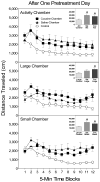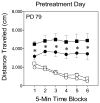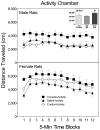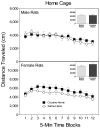Importance of environmental context for one- and three-trial cocaine-induced behavioral sensitization in preweanling rats
- PMID: 19636537
- PMCID: PMC2866166
- DOI: 10.1007/s00213-009-1616-2
Importance of environmental context for one- and three-trial cocaine-induced behavioral sensitization in preweanling rats
Abstract
Rationale: Preweanling rats, unlike adults, exhibit context-independent behavioral sensitization after a single pretreatment injection of cocaine.
Objective: The purpose of this study was to examine environmental factors modulating one- and three-trial sensitization in preweanling rats.
Methods: For preweanling rats, drug pretreatments occurred on postnatal day (PD) 17-PD 19 (experiment 1) or PD 19 (experiment 2). One set of rats was injected with cocaine (30 mg/kg) and placed in anesthesia ("small"), operant conditioning ("large"), or activity chambers for 30 min. Rats were returned to the home cage and injected with saline. Additional groups of rats were injected with saline and placed in small, large, or activity chambers for 30 min and then injected with cocaine after being returned to the home cage. Control groups were injected with saline at both time points. In separate experiments, rats were pretreated with cocaine or saline and restricted to the home cage. On PD 20, all rats were injected with cocaine (20 mg/kg) and placed in activity chambers where locomotor activity was assessed for 60 min. For comparison purposes, sensitization was also assessed in adult rats.
Results: Adult male and female rats exhibited only context-dependent sensitization, whereas preweanling rats showed context-independent sensitization in a variety of conditions (e.g., when pretreated with cocaine in various novel chambers or the home cage).
Conclusions: These results suggest that nonassociative mechanisms underlying behavioral sensitization are functionally mature in preweanling rats, but associative processes modulating the strength of the sensitized response do not function in an adult-like manner during the preweanling period.
Figures








Similar articles
-
One-trial behavioral sensitization in preweanling rats: differential effects of cocaine, methamphetamine, methylphenidate, and D-amphetamine.Psychopharmacology (Berl). 2011 Oct;217(4):559-71. doi: 10.1007/s00213-011-2316-2. Epub 2011 May 3. Psychopharmacology (Berl). 2011. PMID: 21537939 Free PMC article.
-
Cocaine-induced behavioral sensitization in preweanling and adult rats: effects of a single drug-environment pairing.Psychopharmacology (Berl). 2007 Aug;193(3):323-32. doi: 10.1007/s00213-007-0788-x. Epub 2007 Apr 21. Psychopharmacology (Berl). 2007. PMID: 17450351
-
Cocaine-induced behavioral sensitization in the young rat.Psychopharmacology (Berl). 2000 Aug;151(2-3):291-8. doi: 10.1007/s002130000377. Psychopharmacology (Berl). 2000. PMID: 10972476
-
One-trial cocaine-induced behavioral sensitization in preweanling rats: role of contextual stimuli.Exp Clin Psychopharmacol. 2010 Jun;18(3):284-95. doi: 10.1037/a0019142. Exp Clin Psychopharmacol. 2010. PMID: 20545393 Free PMC article. Clinical Trial.
-
Early ontogeny of D-amphetamine-induced one-trial behavioral sensitization.Pharmacol Biochem Behav. 2013 Mar;104:154-62. doi: 10.1016/j.pbb.2013.01.016. Epub 2013 Jan 27. Pharmacol Biochem Behav. 2013. PMID: 23360956 Free PMC article.
Cited by
-
Importance of D1 and D2 receptor stimulation for the induction and expression of cocaine-induced behavioral sensitization in preweanling rats.Behav Brain Res. 2017 May 30;326:226-236. doi: 10.1016/j.bbr.2017.03.001. Epub 2017 Mar 8. Behav Brain Res. 2017. PMID: 28284952 Free PMC article.
-
Importance of associative learning processes for one-trial behavioral sensitization of preweanling rats.Behav Pharmacol. 2011 Oct;22(7):693-702. doi: 10.1097/FBP.0b013e32834affb2. Behav Pharmacol. 2011. PMID: 21897205 Free PMC article.
-
Ontogeny of methamphetamine-induced and cocaine-induced one-trial behavioral sensitization in preweanling and adolescent rats.Behav Pharmacol. 2012 Aug;23(4):367-79. doi: 10.1097/FBP.0b013e32835651c9. Behav Pharmacol. 2012. PMID: 22732208 Free PMC article.
-
Effects of repeated RU 24969 treatment on the locomotor activity, motoric capacity, and axillary temperatures of male and female preweanling rats.Behav Brain Res. 2021 Feb 1;398:112982. doi: 10.1016/j.bbr.2020.112982. Epub 2020 Nov 6. Behav Brain Res. 2021. PMID: 33166571 Free PMC article.
-
One-trial behavioral sensitization in preweanling rats: differential effects of cocaine, methamphetamine, methylphenidate, and D-amphetamine.Psychopharmacology (Berl). 2011 Oct;217(4):559-71. doi: 10.1007/s00213-011-2316-2. Epub 2011 May 3. Psychopharmacology (Berl). 2011. PMID: 21537939 Free PMC article.
References
-
- Adams J, Buelke-Sam J, Kimmel CA, Nelson CJ, Reiter LW, Sobotka TJ, Tilson HA, Nelson BK. Collaborative behavioral teratology study: protocol design and testing procedures. Neurobehav Toxicol Teratol. 1985;7:579–586. - PubMed
-
- Anagnostaras SG, Robinson TE. Sensitization to the psychomotor stimulant effects of amphetamine: modulation by associative learning. Behav Neurosci. 1996;110:1397–1414. - PubMed
-
- Anagnostaras SG, Schallert T, Robinson TE. Memory processes governing amphetamine-induced psychomotor sensitization. Neuropsychopharmacology. 2002;26:703–715. - PubMed
-
- Badiani A, Camp DM, Robinson TE. Enduring enhancement of amphetamine sensitization by drug-associated environmental stimuli. J Pharmacol Exp Ther. 1997;282:787–794. - PubMed
-
- Battisti JJ, Chang CH, Uretsky NJ, Wallace LJ. Sensitization of stereotyped behavior to amphetamine is context and response dependent. Pharmacol Biochem Behav. 1999a;63:263–269. - PubMed
Publication types
MeSH terms
Substances
Grants and funding
LinkOut - more resources
Full Text Sources

